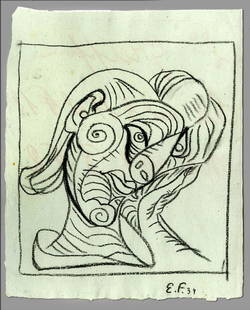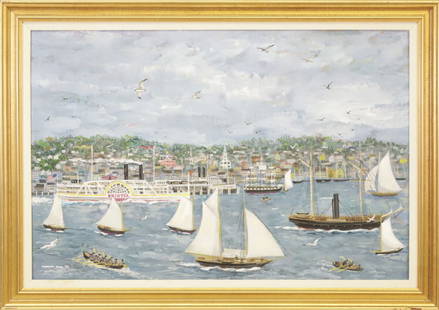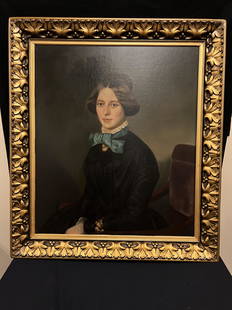
Fernando Amorsolo (1892 - 1972) - Woman at the Fall of Bataan
Similar Sale History
View More Items in Militaria & War Memorabilia

Related Militaria & War Memorabilia
More Items in Militaria & War Memorabilia
View MoreRecommended Collectibles
View More


Item Details
Description
Woman at the Fall of Bataan
signed and dated 1946 (lower right)
oil on canvas
19 1/4” x 15 1/4” (49 cm x 39 cm)
Accompanied by a certificate issued by Mrs. Sylvia Amorsolo-Lazo confirming the authenticity of this lot
PROVENANCE: Private collection, Manila
WRITE UPBeauty Rising Above War Fernando Amorsolo“For sympathetic Filipino civilians who lined the road as the march passed through native barrios, efforts to offer food, water, or other aid to POWs often brought swift retribution. Likewise, the slightest show of resistance toward the demands of the conquerors could mean instant death.” “The streets of the town were lined with elderly civilians and a few small children, who stared silently as the marchers filed past. The Filipinos’ faces were drawn with sorrow, and many had tears running down their cheeks.” “The compassion displayed by Filipino civilians in town after town through which the march passed—always at great risk to themselves— not only prevented hundreds of prisoners from collapsing from starvation but also inspired them to keep pressing on.” — BILL SLOAN, IN ‘UNDEFEATED: AMERICA’S HEROIC FIGHT FOR BATAAN AND CORREGIDOR’ “Another time, I saw a civilian woman bayoneted. Of course, on this [Death] March, the road was also full of civilians. They didn’t know what was going on. There were times when we’d come up to a group of women and kids. I saw a Japanese guard by the side of the road known a woman down, then slide his bayonet into her. That was the type of thing you saw going on.” - Excerpts from the account of Pfc. Cletis Overton, 27th Bombardment Group, Published in the book ‘Death March: The Survivors of Bataan’ by Donald Knox “The surrendered Filipino-American troops were forced at gunpoint to march from Bataan to San Fernando, Pampanga, under the hot tropical sun. Those who could not march because of physical weakness were shot down or bayoneted. So inhuman was the forced march that the event has been called the “Death March.” In Capas, Tarlac, the prisoners were huddled together like animals, hungry and sick.” —TEODORO AGONCILLO, IN “HISTORY OF THE FILIPINO PEOPLE”At the outbreak of the War, Fernando Amorsolo and his family were living near the Far Eastern University, a Japanese garrison at that time. In a September 2022 interview with ANCX, his daughter, Sylvia Amorsolo-Lazo, recounts: “We lived near Azcarraga before the War, but when the Japanese set up a garrison right across the street from our house, my father wanted to keep all the womenfolk safe; so he hired another house, I think it belonged to Mr. Kraut, in Raon. My mother and all the girls were sent there. Papa and the boys stayed in that house on Morayta.” Amorsolo continued painting, albeit faced with difficulties. The University of the Philippines closed down as the Japanese occupied it. Thus, Amorsolo lost his teaching and directorship job at the university (He had been appointed director of the UP School of Fine Arts in 1938, succeeding his uncle Fabian de la Rosa.). Amorsolo would struggle to find his way toward painting commissions to earn a living in those trying times. In Alfredo Roces’ Amorsolo, the author narrates: “Art collector Don Luis Araneta recounted how Amorsolo would come to his office with a small landscape and ask, somewhat hesitantly, if he could possibly get P30.00 for the work.” Aside from commissions, Amorsolo would diligently record and paint the harrowing events of the war years. Roces writes in his monograph: “Amorsolo painted his pictures of the war with no interest in pleasing his customers. He did many oils right on the spot as the emotion moved him. He must have reacted to the need to record the chaos around him.” Amorsolo-Lazo notes in Amorsolo: Love and Passion that “in the face of fear and hunger during World War II,…he kept himself busy drawing and painting the atrocities of war, like a newspaper informing everyone of the sad and cruel events inflicted on our people and places.” In the above-mentioned ANCX article, she recalls: “My father had a collection of newspapers of every single day of the War…[he] was a quiet man, but he was immersed in politics. He was very up to date, very interested in the news. He believed everyone should be.” One of his most poignant paintings of the war was his depiction of tormented civilians, as exemplified by this work titled Woman at the Fall of Bataan. Several accounts concerning the Fall of Bataan and the subsequent Bataan Death March tell of civilians witnessing the brutality of the march. Albeit perilously, they smuggled food and water to the exhausted and dying Filipino–American forces. Painted a year after the liberation of the Philippines from Japanese forces in 1945, the work at hand shows Amorsolo’s lingering pathos and trauma, even at the restoration of liberty and the inauguration of the country’s sovereignty. After the war, old values changed. Everyone scrambled for survival amid a full-blown socio-economic crisis. As a form of catharsis and inner cleansing, Amorsolo translated the harrowing images from his psyche to the canvas. Amorsolo’s famous image of the dalaga has been stripped of her sweetness and is now possessed with agony and hopelessness. In desperate pleas and anguished prayers, her desolate eyes painfully look up to the heavens, now filled with dreariness, as if the Almighty had already abandoned His people. In the absence of Amorsolo’s exuberant Philippine sunlight, darkness pervades the background, with destructive flames engulfing what was once a golden landscape. A famous iteration of this piece can be found at the Silvana and Juan C. Laya Hall of the National Museum of Fine Arts: Bataan, painted by Amorsolo in 1942, shortly after the Fall of Bataan on April 9, 1942. (Adrian Maranan)
Buyer's Premium
- 25%
Fernando Amorsolo (1892 - 1972) - Woman at the Fall of Bataan
Estimate ₱4,600,000 - ₱5,980,000
3 bidders are watching this item.
Shipping & Pickup Options
Item located in Makati City, Metro Manila, phSee Policy for Shipping
Payment

TOP
































![African-American Woman Tintype- Texas Estate: Civil War era sixth plate tintype of an African-American woman, possibly enslaved, found in a Texas estate. [Union, Confederate, Abolitionist, Slavery]](https://p1.liveauctioneers.com/7226/190854/96150542_1_x.jpg?height=310&quality=70&version=1610140980)
![(1865) Distress re: Fall of the Confederacy: Autograph letter signed by Agnes E. Patteson (b. 1835), to her cousin Jim. Hickory Hill, [Hinds County, Mississippi], 9 July 1865. 3 pages, 4to, 7 5/8 x 9 3/4 in. A fascinating letter written in the i](https://p1.liveauctioneers.com/7226/325455/175169172_1_x.jpg?height=310&quality=70&version=1712370394)
![Swisshelm, Jane Grey Cannon (1815-1884) Autograph Letter Signed, Zozonia, [Indiana County, Pennsylva: Swisshelm, Jane Grey Cannon (1815-1884) Autograph Letter Signed, Zozonia, [Indiana County, Pennsylvania], 17 August 1869. Single leaf of wove unlined writing paper, inscribed over two pages to a Mr. F](https://p1.liveauctioneers.com/199/329110/177493334_1_x.jpg?height=310&quality=70&version=1715278896)












![[CIVIL WAR] Captured Confederate Photo, Trophy of War: Hand-colored studio CDV portrait of an elegant woman identified as Miss E. Tenyson. [Virginia?], n.d. Period ink inscription to mount recto: "Miss E. Tenyson, Virginia". Period ink inscription to vers](https://p1.liveauctioneers.com/7226/325455/175169046_1_x.jpg?height=310&quality=70&version=1712944213)






![George Washington Signed Discharge: Partly printed discharge document signed by George Washington, as Commander in Chief of the Armies of the United States. Newburgh, [New York], 4 January 1783. 1 page, ## x ## in. Undersigned by Washin](https://p1.liveauctioneers.com/7226/322253/173251475_1_x.jpg?height=310&quality=70&version=1710004847)
![[Ambrotype] Texas Confederate Soldier: Sixth plate ambrotype. Full leatherette case. Portrait of a possible Texas Confederate soldier. A silver star device was used to pin up the brim of his light-toned headgear, a look often seen in image](https://p1.liveauctioneers.com/7226/322253/173251509_1_x.jpg?height=310&quality=70&version=1710004847)
![Captured Bowie Knife w/ Period Note of Provenance: Captured Confederate D-hilt Bowie knife. [Kenansville, North Carolina]: [Louis Froelich factory]. With original metal and leather sheath with affixed period notes. First note with only remnants. Secon](https://p1.liveauctioneers.com/7226/325455/175169154_1_x.jpg?height=310&quality=70&version=1712370394)
![[Civil War] Bullet Which Nearly Killed Soldier: Lead bullet encased in gold acorn fob with chain. Finely engraved: "W.D. Fiske / 14th Regt. C V / Fredericksburg / Dec 17, 1863." Acorn approx. 1 1/2 x 1 in. Overall length 6 1/2 in. Published in "Her](https://p1.liveauctioneers.com/7226/325455/175169103_1_x.jpg?height=310&quality=70&version=1712370394)
![[CIVIL WAR] 1st Texas Infantry in Camp: Outdoor half plate ambrotype of the 1st Texas Infantry. Full leatherette case. Significant, large half plate ambrotype of members of the 1st Texas Infantry at ‘Splinterville,’ the regiment’s win](https://p1.liveauctioneers.com/7226/322253/173251512_1_x.jpg?height=310&quality=70&version=1710004847)
![[HANCOCK, John] Washington’s Spy, Officer’s Commission: Partly printed document signed by John Hancock as President of the Continental Congress, for Epaphras Bull (1748-1781). [Philadelphia, Pennsylvania], 10 January 1777. 1 page, ## x ## in. Completed in](https://p1.liveauctioneers.com/7226/322253/173251471_1_x.jpg?height=310&quality=70&version=1710004847)

![[Civil War] Cavalry Regiment's Colors : Regulation Civil War Cavalry Regimental flag, c. 1861-1865. Hand-painted and gilded on silk. Approx. 34 x 31 inches. Trimmed on three sides with gold silk fringe. Extremely fine Federal regulation han](https://p1.liveauctioneers.com/7226/325455/175169108_1_x.jpg?height=310&quality=70&version=1712370394)

![[CIVIL WAR] Presented Ames Sword, 16th New York Light Artillery : Fine m1850 foot officer's sword presented to Lieutenant Henry C. Jackson, 27th New York Infantry and 16th New York Light Artillery. Solingen, [Germany]: W. Clauberg and Ames, Chicopee MA hallmarks. Re](https://p1.liveauctioneers.com/7226/325455/175169097_1_x.jpg?height=310&quality=70&version=1712370394)
![Historic Einstein Signed Program from Lincoln University Visit: Conferences on Objectives. Lincoln University, [Oxford], Pennsylvania, 3 May 1946. SIGNED BY ALBERT EINSTEIN. Tipped into Horace Mann Bond (1904-1972). The Education of the Negro in the American Socia](https://p1.liveauctioneers.com/7226/322253/173251693_1_x.jpg?height=310&quality=70&version=1710004847)







